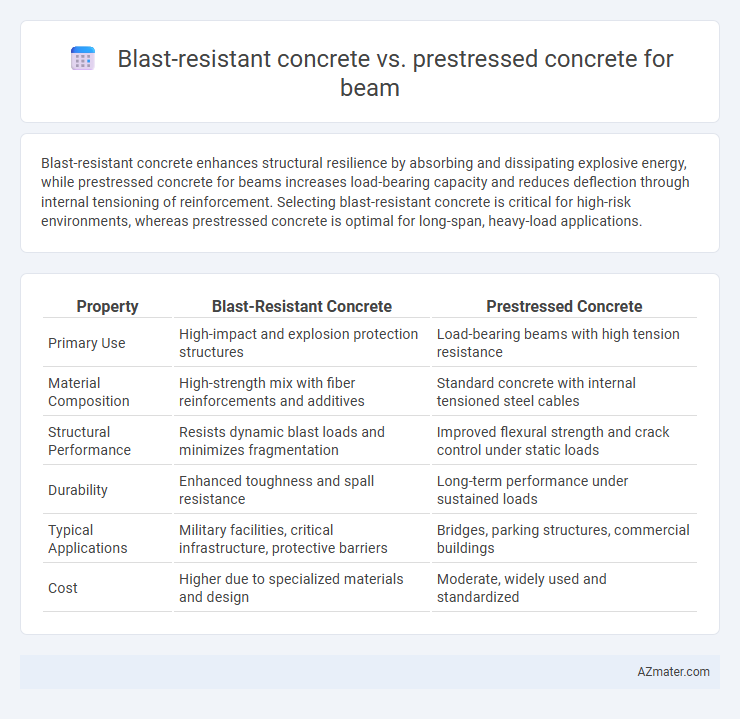Blast-resistant concrete enhances structural resilience by absorbing and dissipating explosive energy, while prestressed concrete for beams increases load-bearing capacity and reduces deflection through internal tensioning of reinforcement. Selecting blast-resistant concrete is critical for high-risk environments, whereas prestressed concrete is optimal for long-span, heavy-load applications.
Table of Comparison
| Property | Blast-Resistant Concrete | Prestressed Concrete |
|---|---|---|
| Primary Use | High-impact and explosion protection structures | Load-bearing beams with high tension resistance |
| Material Composition | High-strength mix with fiber reinforcements and additives | Standard concrete with internal tensioned steel cables |
| Structural Performance | Resists dynamic blast loads and minimizes fragmentation | Improved flexural strength and crack control under static loads |
| Durability | Enhanced toughness and spall resistance | Long-term performance under sustained loads |
| Typical Applications | Military facilities, critical infrastructure, protective barriers | Bridges, parking structures, commercial buildings |
| Cost | Higher due to specialized materials and design | Moderate, widely used and standardized |
Introduction to Concrete Types for Beams
Blast-resistant concrete for beams is specifically engineered to withstand high-impact forces and explosive loads, incorporating materials like fiber reinforcement and dense aggregates to enhance durability and energy absorption. Prestressed concrete beams utilize tensioned steel tendons to counteract tensile stresses, improving load-bearing capacity and reducing deflections for long-span applications. Both concrete types optimize structural performance but address distinct challenges: blast resistance for safety-critical infrastructures and prestressing for efficient load management in bridges and buildings.
Understanding Blast-Resistant Concrete
Blast-resistant concrete is engineered to absorb and dissipate energy from explosions, incorporating high-strength aggregates and dense microstructures to enhance durability under extreme pressure. Its design focuses on minimizing structural damage and preventing fragmentation upon blast impact, unlike prestressed concrete, which primarily improves load-bearing capacity through tensile stress application. Understanding blast-resistant concrete's composition and behavior under shock loads is crucial for constructing safer beams in high-risk environments such as military, industrial, and infrastructure facilities.
Fundamentals of Prestressed Concrete
Blast-resistant concrete enhances structural resilience by incorporating dense aggregates and fiber reinforcement to absorb and dissipate explosive energy. Prestressed concrete fundamentally relies on pre-tensioning or post-tensioning steel tendons to induce compressive stresses, counteracting tensile forces during loading and improving beam performance. This technique significantly increases load-carrying capacity and durability by controlling crack development and deflection under service conditions.
Structural Performance Under Extreme Loads
Blast-resistant concrete for beams is engineered with high-density aggregates and fiber reinforcements to absorb and dissipate energy from extreme loads, minimizing spalling and structural failure. Prestressed concrete beams utilize tensioned steel tendons to introduce compressive stresses, enhancing load-bearing capacity and crack control under dynamic impacts. Comparative studies show blast-resistant concrete excels in energy absorption while prestressed concrete offers superior tensile strength and durability against cyclic loading.
Material Composition and Engineering Differences
Blast-resistant concrete incorporates high-strength aggregates, fibers such as steel or polypropylene, and specialized admixtures to enhance energy absorption and prevent spalling under explosive loads. Prestressed concrete beams utilize high-tensile steel tendons tensioned before or after casting to induce compressive stresses, improving load-bearing capacity and controlling deflections under service loads. Material-wise, blast-resistant concrete emphasizes toughness and ductility, while prestressed concrete focuses on tension-compression balance achieved through engineered preloading techniques.
Cost Considerations and Construction Efficiency
Blast-resistant concrete beams typically incur higher costs due to the specialized materials and thicker cross-sections required to withstand explosive forces, increasing both material expenditure and labor intensity. Prestressed concrete beams offer enhanced construction efficiency by reducing beam size and weight, which lowers formwork and transportation costs, and enables faster installation schedules. While blast-resistant concrete emphasizes safety over cost, prestressed concrete optimizes economic viability and construction speed in non-hazardous environments.
Durability and Long-term Maintenance
Blast-resistant concrete offers enhanced durability through increased density and high-strength aggregates, effectively absorbing and dissipating impact energy, which reduces structural damage under explosive loads. Prestressed concrete beams exhibit superior long-term performance by mitigating tensile stress and controlling crack propagation, resulting in reduced maintenance requirements and extended service life. Both materials provide durability benefits, but blast-resistant concrete prioritizes impact resilience, while prestressed concrete emphasizes structural integrity and maintenance efficiency over time.
Safety Standards and Building Codes
Blast-resistant concrete beams are designed according to specialized safety standards such as UFC 3-340-02 and are reinforced to withstand extreme explosive forces, ensuring enhanced protection in high-risk environments. Prestressed concrete beams follow building codes like ACI 318, focusing on structural efficiency and load-bearing capacity, which improve overall durability but do not specifically address blast impacts. Compliance with appropriate standards is critical; blast-resistant concrete ensures safety against explosions while prestressed concrete optimizes performance under conventional load conditions.
Application Scenarios and Use Cases
Blast-resistant concrete beams are engineered for high-impact environments such as military facilities, industrial plants, and security-sensitive infrastructure, providing enhanced protection against explosions and shockwaves. Prestressed concrete beams excel in long-span bridges, parking structures, and commercial buildings, optimizing load-bearing capacity and reducing material use by pre-tensioning steel reinforcement. Selecting between blast-resistant and prestressed concrete depends on specific application requirements like structural safety under explosive forces or maximizing strength and durability for heavy loads.
Choosing the Right Concrete for Beam Projects
Blast-resistant concrete offers enhanced durability and energy absorption properties ideal for structures exposed to explosive forces, whereas prestressed concrete provides superior tensile strength and crack resistance for heavy load-bearing beams. Selecting the right concrete depends on project-specific requirements such as load conditions, environmental hazards, and safety standards. Integrating blast-resistant concrete improves impact resilience, while prestressed concrete optimizes structural efficiency and longevity in conventional beam applications.

Infographic: Blast-resistant concrete vs Prestressed concrete for Beam
 azmater.com
azmater.com